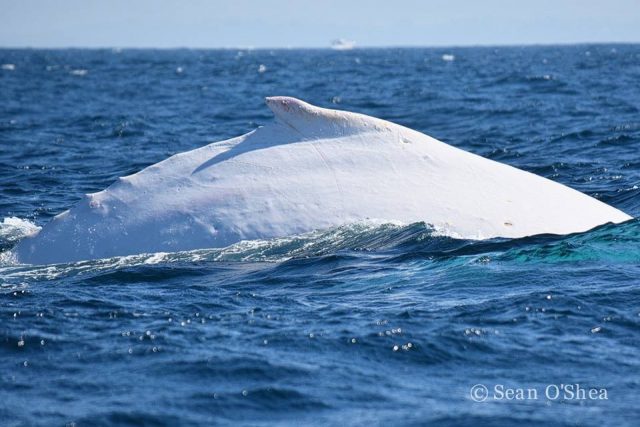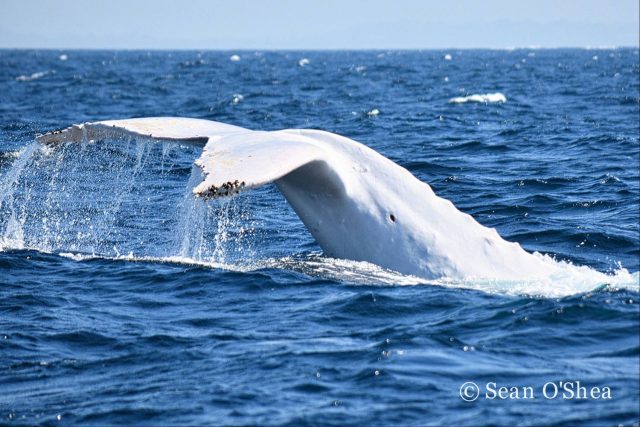
 Migaloo the famous white humpback whale has been spotted off the Northern NSW coastline, and was heading towards Gold Coast waters late yesterday.
Migaloo the famous white humpback whale has been spotted off the Northern NSW coastline, and was heading towards Gold Coast waters late yesterday.
Southern Cross University whale researcher Dr Wally Franklin, who first met Migaloo in 1992, says the majestic whale had arrived “right on time”.
Dr Franklin’s son Mark Franklin, Technical Director of The Oceania Project, was aboard the Wild Byron whale watching tour boat which spotted Migaloo around midday yesterday (July 26) more than 10km off the coast of Brunswick Heads, north of Byron Bay.
“We had been looking out for whales but originally we weren’t finding any. Then we saw a whale breaching in the distance,” Mark said.
“As we got there we couldn’t believe it, as we were not expecting to see Migaloo. It was utterly amazing.
“He was tail lobbing – that’s when a whale puts its fluke out of the water and splashes it down. He was travelling with other whales, there were two others in his company.”
For about an hour the crew watched and took photos as the pod continued towards the Queensland border on its northern migration. Byron Bay photographer Sean O’Shea was on the boat and captured the once-in-a-lifetime encounter.
Dr Franklin said Migaloo usually travels around 4 miles an hour (6.5km/h) and could have reached Queensland waters by yesterday afternoon or passed the state border during the night.
“There are sightings of him almost every year, but we’ve had no prior reported sightings of Migaloo during this migration. As far as we know this is the first reported sighting of Migaloo this season. Usually we have earlier reports of him coming through the waters of Cook Island or New Zealand earlier in July,” Dr Franklin said.
Dr Franklin said Migaloo – known to be a wide-ranging male – would likely travel into the southern part of the Great Barrier Reef Lagoon, however he might decide to go further as he has been sighted off Cairns and Port Douglas in the past.
The first official sighting of Migaloo was 1991 in the waters near Byron Bay, though there had been reports of a white whale calf being spotted two years earlier off Woolongong. Scientists believe Migaloo was likely born in 1989, which makes him 30 next year.
Dr Wally Franklin and his wife Dr Trish Franklin first set eyes on Migaloo in 1992 and again in 1993 near Hervey Bay; then in 1998 they recorded him ‘singing’ (which can be listened to at Soundcloud.com/iwhales) a behaviour typical of male whales around nine years old.
It was Southern Cross University humpback researcher Dr Dan Burns and his team who first collected skin samples of Migaloo in October 2004, as he passed Ballina in Northern NSW on his return journey to the Antarctic, which confirmed the whale’s gender.
In 2011 David Paton, who was then a Southern Cross University researcher but now runs organisation Blue Planet, co-authored a journal article describing the whale’s albino colouring – which makes Migaloo one in 33,000.
Dr Wally Franklin said the there was only a small chance Migaloo could be the father of the white whale calf recently spotted off Ballina, which a skin sample might one day determine. Dr Franklin said early sightings had not determined whether the whale calf was completely white and it was possible it would darken with age.
“Albinism in whales derives from a recessive gene which results in the white colouring of the skin, so for Migaloo to father a white calf he would have to interact with a female who also carried the recessive gene and both would have to pass on that half of their gene and there is a low probability of that occurring.”
Dr Franklin said Migaloo is definitely a “special interest” whale, particularly in Queensland waters, and cautioned the importance of vessels to not approach him any closer than 500m metres. There are also strict rules in place to stop helicopters, charter boats and drones from getting too close.
“It’s very important to give Migaloo plenty of space and if vessels do approach him they must leave at least 500m and only approach from his left or right flank, never from directly astern or ahead of him as that could interrupt his behaviour and migratory patterns.”
All photos credit Sean O’Shea.
Facebook: https://www.facebook.com/SeanOSheaArt/
Instagram: @seanosheaart
Website: http://www.seanoshea.com.au
